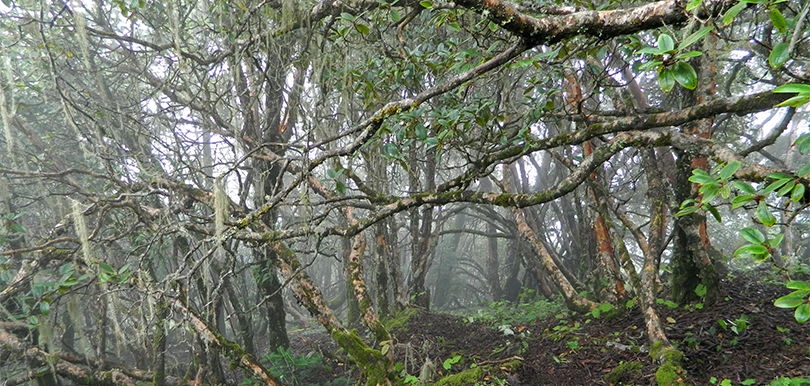Stable treeline: How a valley in the Himalayas is defying climate changeThe Himalayas are experiencing rising temperatures and longer growth periods – so why isn’t the treeline advancing uphill? That’s a question that Niels Schwab and Birgit Bürzle from the Institute of Geography are investigating.
25 April 2017, by Franziska Neigenfind

Photo: UHH/N. Schwab
The Himalayas are experiencing rising temperatures and longer growth periods – so why isn’t the treeline advancing uphill?
The small village of Beding clings to the side of a cliff, roughly 3,700 meters above sea level in the untamed Rolwaling Valley – approximately 100 kilometers east of the Nepalese capital, Kathmandu. Here, in the mountainous world of the Himalayas, climate change is progressing faster than elsewhere in the world: on-site measurements and trend calculations indicate that the average air temperature at this altitude rose by 1.5 degrees Celsius between 1991 and 2012. Yet, while rising temperatures have led the treeline to advance in other mountainous regions, in Rolwaling it hasn’t budged an inch. That would seem paradoxical, since the higher reaches now offer a sufficiently long vegetation period for trees. Why, then, has the treeline remained so stable?
My colleague Birgit Bürzle and I traveled to the valley to take a closer look at this phenomenon. In an interdisciplinary project, we researchers at Universität Hamburg’s Center for Earth System Research and Sustainability are currently investigating the treeline around Beding, where the forest ends in a krummholz belt: due to the short vegetation periods and low temperatures, the trees grow into stunted krummholz. Whereas the krummholz zone in the Alps chiefly consists of mountain pine, the woods surrounding Beding are dominated by hardy rhododendron bushes. Only two to three meters tall, they form virtually impenetrable thickets.
The undisturbed treeline offers optimal conditions for our research; such untouched transitional zones between two different ecosystems are hard to come by; in the Alps, for example, they’ve all but disappeared. Since human beings cleared away trees there in the higher altitudes, and areas once used as alpine pastures were later reclaimed by the forests, the lines between climate-change-related and anthropogenic effects have become too blurred. In contrast, the northern cliffside near Beding has remained unchanged, because the Buddhists believe it to be sacred.
Here we surveyed the vegetation at four different heights – including the level of the rhododendron belt, and the areas directly uphill and downhill of it. I counted and mapped the trees, recorded the diameters of their trunks and canopies, and gathered wood samples. In addition to rhododendrons, the area is also home to birches, pines, ashes, maples and junipers.
In addition, my colleague explored all the plant communities; beyond trees and saplings, these include all shrubs, herbs and grasses. Though she found over 100 species in the survey area, she also determined that only 12 of them grow in the krummholz belt, and the chances of new species settling there seem practically nonexistent.
Our studies show that the composition of the vegetation and the position of the treeline don’t just depend on the temperature, but also on the available nutrients and topography. In addition, the evergreen rhododendrons create inhospitable conditions for other plants: since they grow together so densely, very little sunlight makes its way to the topsoil. And even if a seed manages to germinate into a plantlet, its roots will hardly be able to penetrate the hard-to-decompose leaves in the soil. There is also evidence suggesting that rhododendron leaves release growth-inhibiting toxins, allowing the plants to protect their habitat from invasion by other species. At the same time, the plants themselves form a physical barrier, preventing plants in the transitional zone from migrating up to the treeline – an obstacle that seeds can’t overcome, either. In fact, this is so effective that it has prevented the treeline from shifting, despite climate change.
This article was first published as a guest article in the newspaper Hamburger Abendblatt on April 10th 2017.
Niels Schwab and Birgit Bürzle are members of the Biogeography and Landscape Ecology Working Group at Universität Hamburg’s Institute of Geography.
